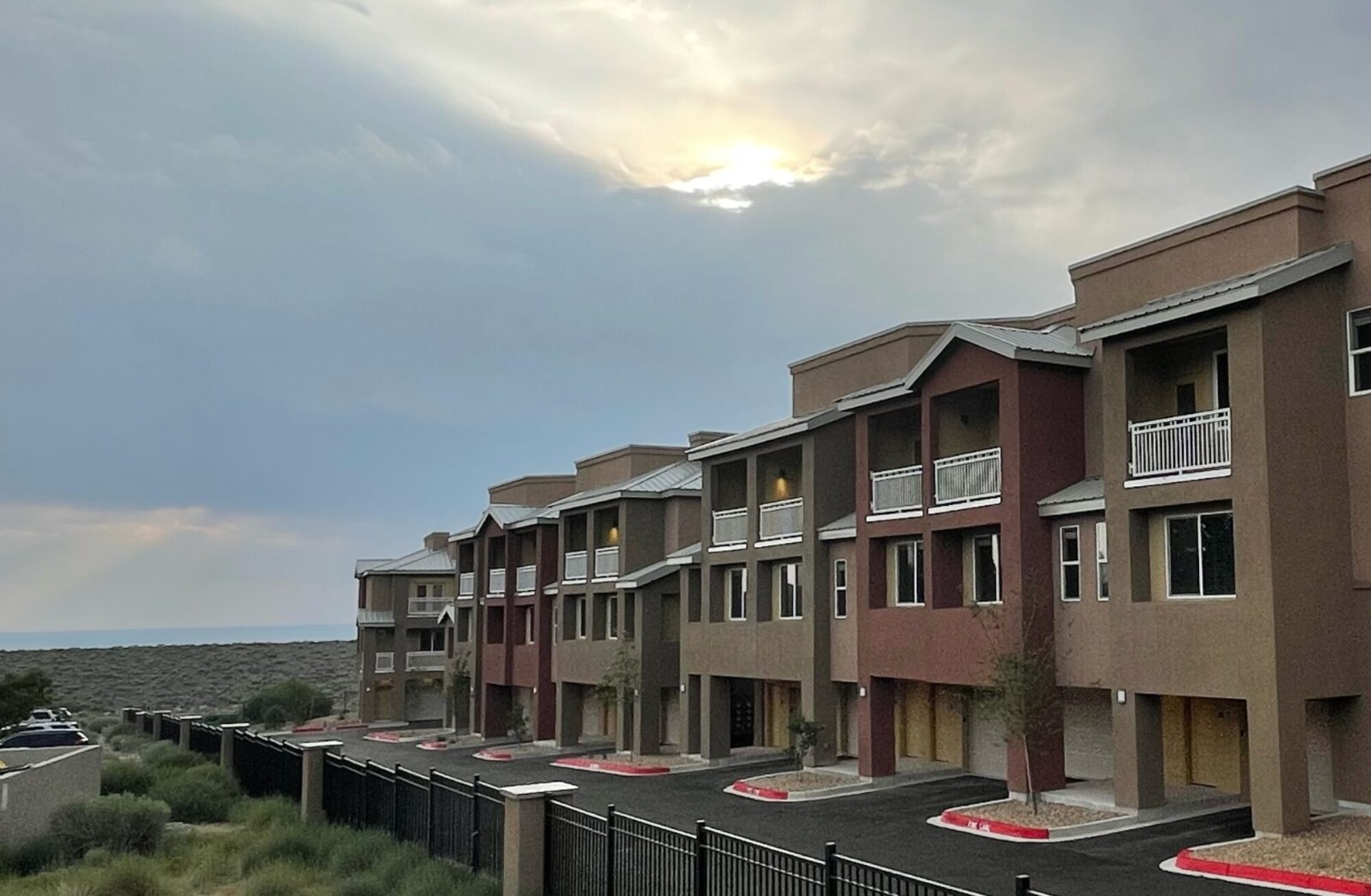New Mexico Needs More Housing
According to federal standards, a family earning 100 percent of median income in New Mexico, $69,208 a year, can afford to pay $1,730 a month for housing costs.
The monthly loan payment for the average home in New Mexico, about $292,341, is $2,247. The median income for a family of four in New Mexico’s largest City, Albuquerque is $75,500, and by the same standard, that family should be able to pay $1,887 for rent per month. The average monthly cost of a 3-bedroom home in Albuquerque is $1,995.
According to the Harvard Joint Center on Housing, many families, even when their housing costs are 30 percent of their monthly income, still struggle to pay for other important needs like childcare and transportation. People at lower levels of income, of course, find the gap between what they earn and what they can pay for housing even larger, and this burden is inequitably carried by Black, Native, and Latino families in the state.
When demand for housing increases, and production of new housing fails to keep up, housing is scarce. Scarcity means people who need housing have to compete with each other, and that means people with more money will win. The solution is to create policies, incentives, and financing strategies that create resources for people who need housing while at the same time encourage investment in new housing production.
In 2022, the Governor signed Senate Bill 134, legislation that will “generate an estimated $20-25 million annually” for housing. We must ensure that a significant portion of that funding is reserved for innovative projects to expand housing supply and avoid mingling those funds with federal dollars. Federal programs come with many requirements that leverage local dollars to fulfill federal goals. Instead, funds generated in New Mexico should support projects that are driven by local needs and ideas.
Strong, Innovative Housing Solutions for our NM Community Members
The following proposals would expand housing supply, access, and create more jobs and economic activity. Those that require state funding are noted with a $ symbol.
Local Economic Development Act (LEDA) and the New Mexico Redevelopment Code
New Mexico has two powerful tools for local governments to incentivize economic development through jobs creation and new development. They should be amended as follows,
- Qualifying entities under LEDA must analyze the impact of new jobs on housing demand, define additional housing needs, and propose options to create new housing to meet that need.
- Local governments granting tax abatements to private entities under the Redevelopment Code must assess housing impact and include an option for affordable housing on site or contributing to affordable housing projects elsewhere in the designated redevelopment area.
Create a Multifamily Tax Abatement Program
Authorize local jurisdictions to offer up to 15 years of tax abatement for new and existing multifamily housing projects in exchange for inclusion of units with reduced rent for the full length of the abatement. The state should preempt local governments from any other inclusionary requirements or fees in lieu.
Create a Casita Revolving Fund $
In order to increase the supply of affordable rental housing, the Mortgage Finance Authority (MFA) should create and manage a revolving fund that will offer financing to homeowners at 100 percent of Area Median Income (AMI) or less based on the rent potential of a detached accessory dwelling unit on their property. The MFA would manage the construction of projects using local contractors using performance-based contracting. The MFA can partner with local banks and credit unions to service loans.
Pilot a “Cash for Rent” Program $
Emergency Rental Assistance Program (ERAP) was established and became known as a temporary covid era program. In January, 2023, they stopped accepting new applications. We need to make sure we have the funding and support to create a long-term program such as this, as it addresses our rent disparity problem now and in the meantime of the expansion of housing supply.
Currently the Department of Housing and Urban Development (HUD) is looking for local partners to implement a pilot program offering fast, cash rental assistance to families experiencing housing cost burden. New Mexico should implement a program in collaboration with local housing authorities to consider all household costs along with housing and offer qualified households direct monthly cash assistance and compare the effectiveness of this program compared to HUDs current voucher program. Other guaranteed income programs HERE.
Cooperative Housing and Community Land Trusts $
Cooperatively owned housing gives people with less money a chance to build equity over time without a mortgage and community land trusts lock in affordability by limits on resale that keep housing affordable. Cooperatives on community land trusts have enabled equity and preserved affordability. The legislature should appropriate funds to pilot two housing projects using cooperative homeownership on a community land trust to determine the effectiveness of these ownership models on creating better access to homeownership among people with lower incomes, especially Black and Native families that have much lower rates of homeownership than White families. One project will be in a rural community and the other in an urban community.
Faster, More Efficient Supply: Link State Housing Trust Fund Dollars to Local Performance
The key to solving housing shortages that create high prices that hurt many New Mexicans is allowing the construction of new housing. Often local rules and zoning slow down production. The administrative time costs associated with enacting these rules increase prices and rents and reducing these costs can mean lower housing costs for consumers.
Any local urban jurisdiction wishing to access Housing Trust Funds must:
- Complete a market-based assessment of housing needs based on projected population growth, projected job growth, and current inventory;
- The plan should include implementation of zoning changes to allow more density for housing in all areas and zoning changes that would increase housing supply, like allowing for duplexes on lots currently zoned for only one house;
- Update the assessment annually;
- The assessment of need for affordable housing cannot rely solely on “cost burden” using previous years Census data. Planning for new housing investment should include metrics used by the private sector for investment in housing development:
- Population and job growthPermitting time (time to delivery) for new housingVacancy and absorption rates
- Economic indicators (e.g. interest rates, materials cost, rates of inflation, etc.)
- Rent growth
- A current, annual measure of the effects of permitting times and regulation on issuance of permits for new housing
- Measure of the effects of permitting must include a measure of the length of time from issuance of permit to issuance of a certificate of occupancy
- Appropriate funds to support this work, including additional review and inspection staff, technical assistance, and legal assistance if justified through study of the permitting process $
- Provide a funding bonus for jurisdictions with the most improvements in delivery time, measurable increases in housing supply, and stability of housing prices and rents
Fund a Study a Cost Audit of Low-Income Housing Tax Credit (LIHTC) Housing $
The State Auditor will conduct a comprehensive study of the costs of producing housing units using LIHTC allocated to the Mortgage Finance Authority. The study will, determine the efficiency and cost effectiveness of LIHTC Housing as a solution to affordable housing:
- Longitudinally compare LIHTC projects with typical market rate projects,
- Measure the differences in cost and time to delivery between projects using LIHTC and projects not using LIHTC,
- Determine the causes for any differences, and
- Issue recommendations reducing costs and improving efficiency
New Mexico Funds for New Mexico Housing $
The Auditor should conduct a “leverage cost analysis” to measure the costs of capital assembly for housing projects using federal vs. local sources of funds.
Often housing projects “stack” capital which can result in higher costs and force compliance with many requirements from federal agencies or other funding entities outside New Mexico. To encourage local innovation, the legislature should set aside a significant percentage of funds generated from local taxes and revenues for projects with no federal or outside funding. Local projects usually spend precious time and resources assembling various sources of capital, especially federal dollars and tax credits, often driving up the costs. When costs go up, it means fewer units. Federal requirements can also limit which New Mexicans can access housing projects using federal funds.
Housing Transition and Stability Fund
Offer protections to property owners who are willing to rent to “higher risk” tenants with either less than perfect or no credit scores with the creation of a Transition and Stability Fund. For residents that are prequalified, the fund may cover deposits, any damage to units, legal representation, and lost rent for non-payment.
This fund would include resources for the Department of Corrections to develop a program to transition people in the prison system to successfully transition to housing with prerelease training and vouchers for 6 to 12 months to cover housing costs. The program staff would work to incentivize housing providers to participate in the program.
Cooperative and Community Trust Land Demonstration Program $
The legislature will establish a fund to support the acquisition of land and development costs to support the creation of housing projects that offer residents cooperative ownership on community trust land. The fund could use revenue bonding authority to fund construction and the cooperative would match the state’s debt service payments with monthly housing payments from shareholders. When the bonds are retired, cooperative payments would continue to the state until the full cost of construction is paid. This public option program would enable equity building without a bank or investor.
Develop and Fund a Workforce Training Program to Lower Housing Costs $
The legislature will appropriate funds to support a mentorship and training program that will allocate students at state or other universities to work on qualified housing projects. Labor and talent would be free to the housing project in exchange for lower costs or rents for the consumer. This program would provide more affordable housing and a more diverse local workforce.
Fund a Pilot Program for an Alternative Measure of Affordability and Basic Income $
Affordability isn’t just paying 30 percent of household income for housing. Even families who can “afford” housing by that measure still struggle because of other expenses. The legislature will fund a comprehensive program to establish and thoroughly evaluate a New Mexico Standard of Sustainability and Affordability that would support families to transition into more sustainable and affordable living. Measures should include:
- Utilities, property taxes, insurance, and other fixed housing costs;
- Transportation costs;
- Day care, education costs, healthcare costs, etc.
Continue to Fund Down Payment Assistance & Establish a Public Option for lending
We need to continue to incentivize the ability for people to build wealth by buying/owning homes through down payment assistance, credit rebuilding or establishing assistance, alternative sources of funding for repaying a mortgage, public option lending, etc.
Preserve existing homes and homeowners through low-interest loans for rehabilitation and repairs
Create additional funding for the Restore Our Communities program of MFA, including adding preserving existing properties to the already covered vacant and abandoned properties.

